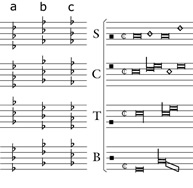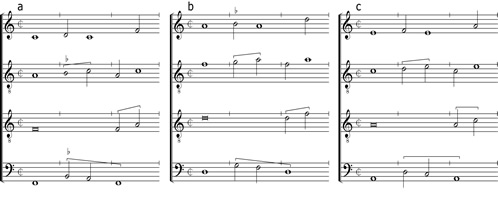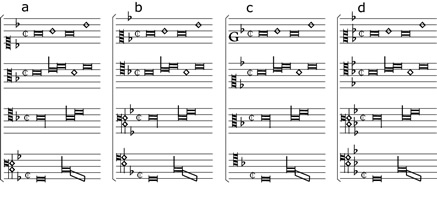Ockeghem’s Missa Cuiusvis toni and fa-clefs
As an offshoot of the investigation of chansons using fa-clef notation (see ‘On chansons notated in fa-clefs’) it is interesting to turn to Johannes Ockeghem’s Missa Cuiusvis toni. Musicologists from Ambros to van Benthem have struggled to design selections of letter clefs to interpret Ockeghem’s notation in such a way that the three possible species of fourths and their related modes – as observed by Glarean – can work in performances. (1) Can superimposing formations of fa-clefs on the mass’ pitch indeterminate notation be of advantage?
As an example we can look at one of the few places in the mass where all four voices start simultaneously, at ‘Osanna’ in the Sanctus, in Chigi Codex ff. 104v–105. The first notes are shown in Example 1 (the different symbols used in the manuscript to indicate the position of the final notes are here replaced by black squares). Three different arrays of fa-clefs in conventional fifth-fourth formations may be imagined in front of the notes (a-c). Default readings will produce performances of the music on ut, re and mi without the use of hexachordal signatures as Example 2a–c show: in C-tonality (Lydian with a flattened fourth), in A-Dorian, and E-Phrygian. If such readings were to be notated and pitch-locked according to the principles we have studied earlier (cf. ‘On chansons’), that is with fa-clefs combined with letter-clefs and superfluous flats removed, they could result in the notations in Example 3a–d – this is definitely hypothetical. The first is in fa-ut (Lydian with a flat signature), the second in D-Dorian, and the third in A-Phrygian. But in the last case as we have seen earlier, a reading which retains all the flats is more probable; it produces a version in D-Phrygian (Ex. 3d).
Examples 1-3, Johannes Ockeghem, Missa Cuiusvis toni – Sanctus
Ex. 1, Beginning of ‘Osanna’ with three arrays of fa-clefs in front (a-c)

Ex. 2, Defaults readings in ut, re and mi (a-c)

Ex. 3, Hypothetical clef combinations (a-d)

It is remarkable how easily fa-clefs operate the different possible modes. For example, the singers have to mentally move just a single flat in every array in order to change from Dorian to Phrygian (compare Ex. 1b and c, and Ex. 3b and d). If arrays of fa-clefs are imagined when performing from the notation of the Chigi Codex it is possible to sing the three modes at the pitches, which best fit the ranges of the singers involved, and all three modes can be performed in the same general tessitura. The notated (still hypothetical) results of these readings as regards the two first (Ex. 3a-b), moreover, agree perfectly with the versions published in van Benthem’s complete edition, while the most probable Phrygian version (Ex. 3d) with regard to tessitura keeps much closer to the normal than the one proposed by van Benthem. (2) It is also interesting that the fa-signs used by the copyist in the Chigi Codex in the second section of Credo (“Et iterum venturus est”, ff. 101v–103) agree with a reading in Dorian (corresponding to Ex. 1b or 3b), as if the scribe for a time forgot that he was copying according to a different principle and relapsed into a fa-clef interpretation. (3)
PWCH February 2010
1) For a detailed explanation of the mass' modal structure, see Jaap van Benthem, ‘‘Prenez sur moy vostre exemple’. Signae, text and cadences in Ockeghem’s Prenez sur moy and Missa Cuiusvis toni’, Tijdschrift van de Koninklijke Vereniging voor Nederlandse Muziekgeschiedenis, 47 (1997), pp. 99–118, at pp. 100–104, and Jeffrey Dean, ‘Okeghem’s attitude towards modality: Three-mode and eight-mode typologies’, in Ursula Günther, Ludwig Finscher, and Jeffrey Dean (eds.), Modality in the music of the fourteenth and fifteenth centuries. Modalität in der Musik des 14. und 15. Jahrhunderts (Musicological studies & documents, 49), Neuhausen-Stuttgart 1996, 203–246, at pp. 233–237.
2) Benthem’s edition proposes a very low Phrygian version on B-mi; cf. Johannes Ockeghem (ed. Jaap van Benthem), Missa Cuiusvis toni upon re and mi(Masses and Mass Sections, fascicle III,3), Utrecht 1996, and Missa Cuiusvis toni upon fa-ut. Missa Prolacionum (Masses and Mass Sections, fascicle III,4, Utrecht 1996.